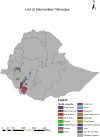Mapping lymphatic filariasis morbidities in 24 endemic districts of Ethiopia through the health extension program
- PMID: 39538312
- PMCID: PMC11559126
- DOI: 10.1186/s41182-024-00657-6
Mapping lymphatic filariasis morbidities in 24 endemic districts of Ethiopia through the health extension program
Abstract
Background: The primary strategy for achieving the second goal of the Global Program to Eliminate Lymphatic Filariasis (GPELF) is morbidity management and disability prevention (MMDP), aimed at alleviating the suffering of affected populations. A significant challenge in many LF-endemic areas is the effective registration and identification of individuals with LF, which is crucial for planning and ensuring access to MMDP services. This study seeks to map the geographical distribution of LF-related morbidities across 24 endemic districts in Ethiopia.
Methods: A community-based cross-sectional study was conducted to identify individuals affected by LF in 24 endemic districts using primary health care units (PHCUs). The study involved 946 trained health extension workers (HEWs) conducting house-to-house visits to identify and register cases of lymphedema and hydrocele, with support from 77 trained supervisors and 87 team leaders coordinating the morbidity mapping. Certified surgeons performed confirmatory evaluations through clinical assessments on a randomly selected sample of cases to validate HEW diagnoses, ensuring accurate identification of lymphedema and hydrocele. Statistical analysis of the data, including the severity of lymphedema and acute attacks, was conducted using STATA 17.
Results: This study involved 300,000 households with nearly 1.2 million individuals, leading to the identification of 15,527 LF cases-14,946 (96.3%) with limb lymphedema and 581 (3.7%) with hydrocele. Among those with lymphedema, 8396 (54.1%) were women. Additionally, 13,731 (88.4%) patients resided in rural areas. Of the 14,591 cases whose acute attack information was recorded, 10,710 (73.4%) reported experiencing at least one acute attack related to their lymphedema in the past 6 months, with a notable percentage of males (74.5%; n = 4981/6686). Among the 12,680 recorded cases of leg lymphedema, the percentage of acute attacks increased with severity: 64% (n = 5618) mild cases, 68% (n = 5169) moderate cases and 70% (n = 1893) severe cases.
Conclusion: This study successfully mapped the geographical distribution of LF morbidities across 24 LF-endemic districts in Ethiopia, identifying a substantial number of lymphedema and hydrocele cases, particularly in rural areas where healthcare access is limited. The findings underscore the potential of Ethiopia's health extension program to identify affected individuals and ensure they receive necessary care. The findings inform targeted interventions and access to MMDP services, contributing to Ethiopia's goal of eliminating LF by 2027.
Keywords: Ethiopia; Hydrocele; Lymphatic filariasis; Lymphedema; Morbidity management and disability prevention; Morbidity mapping.
© 2024. The Author(s).
Conflict of interest statement
Figures


Similar articles
-
Integrated morbidity mapping of lymphatic filariasis and podoconiosis cases in 20 co-endemic districts of Ethiopia.PLoS Negl Trop Dis. 2018 Jul 2;12(7):e0006491. doi: 10.1371/journal.pntd.0006491. eCollection 2018 Jul. PLoS Negl Trop Dis. 2018. PMID: 29965963 Free PMC article.
-
Developing the first national database and map of lymphatic filariasis clinical cases in Bangladesh: Another step closer to the elimination goals.PLoS Negl Trop Dis. 2019 Jul 15;13(7):e0007542. doi: 10.1371/journal.pntd.0007542. eCollection 2019 Jul. PLoS Negl Trop Dis. 2019. PMID: 31306409 Free PMC article.
-
Health beliefs and health seeking behavior towards lymphatic filariasis morbidity management and disability prevention services in Luangwa District, Zambia: Community and provider perspectives.PLoS Negl Trop Dis. 2021 Feb 22;15(2):e0009075. doi: 10.1371/journal.pntd.0009075. eCollection 2021 Feb. PLoS Negl Trop Dis. 2021. PMID: 33617551 Free PMC article.
-
Elimination of lymphatic filariasis as a public health problem from the Arab Republic of Egypt.Acta Trop. 2019 Nov;199:105121. doi: 10.1016/j.actatropica.2019.105121. Epub 2019 Aug 7. Acta Trop. 2019. PMID: 31400299 Review.
-
The story of Lymphatic Filariasis elimination as a public health problem from Yemen.Acta Trop. 2020 Dec;212:105676. doi: 10.1016/j.actatropica.2020.105676. Epub 2020 Aug 20. Acta Trop. 2020. PMID: 32828916 Review.
Cited by
-
Global Preventive and Management Strategies and Their Effectiveness in Patients With Secondary Lymphedema: A Scoping Review.Cureus. 2025 May 7;17(5):e83627. doi: 10.7759/cureus.83627. eCollection 2025 May. Cureus. 2025. PMID: 40486300 Free PMC article. Review.
References
-
- World Health Organization (WHO). Global report on neglected tropical diseases 2023. WHO, Switzerland, Geneva. Available from: https://www.who.int/publications/i/item/9789240067295.
-
- Silvestri V, Mushi V, Ngasala B. Lymphatic filariasis. In: Vascular damage in neglected tropical diseases: a surgical perspective. Cham: Springer; 2024. p. 65–79. 10.1007/978-3-031-53353-2_5.
-
- Sharma A, Sharma D, Vats S, Kamboj A, Sharma P. Lymphatic filariasis and dracunculiasis. In: Emerging approaches to tackle neglected diseases: from molecule to end product. Bentham Science Publishers; 2024 June 21. p. 66–90. 10.2174/97898151968631240101.
LinkOut - more resources
Full Text Sources
Miscellaneous
